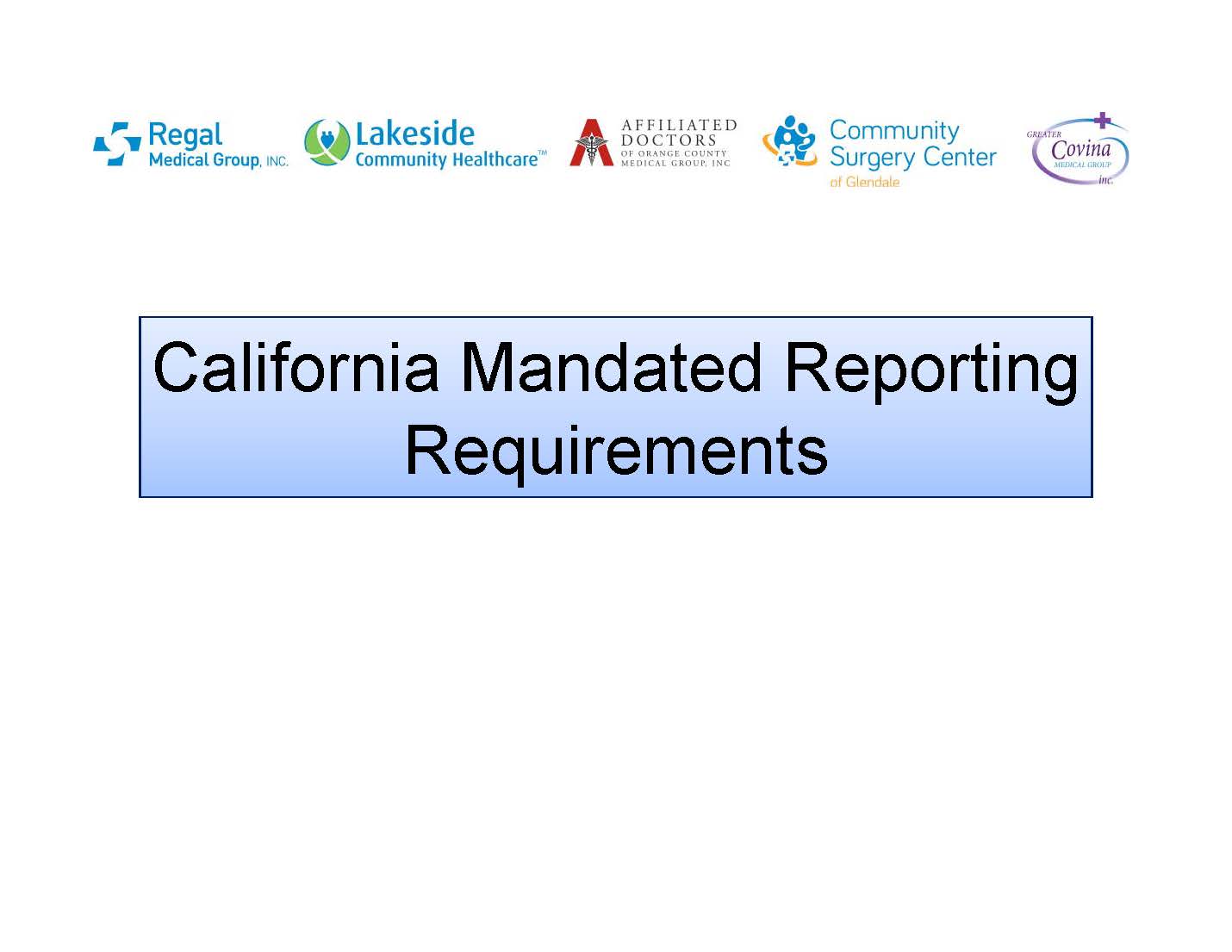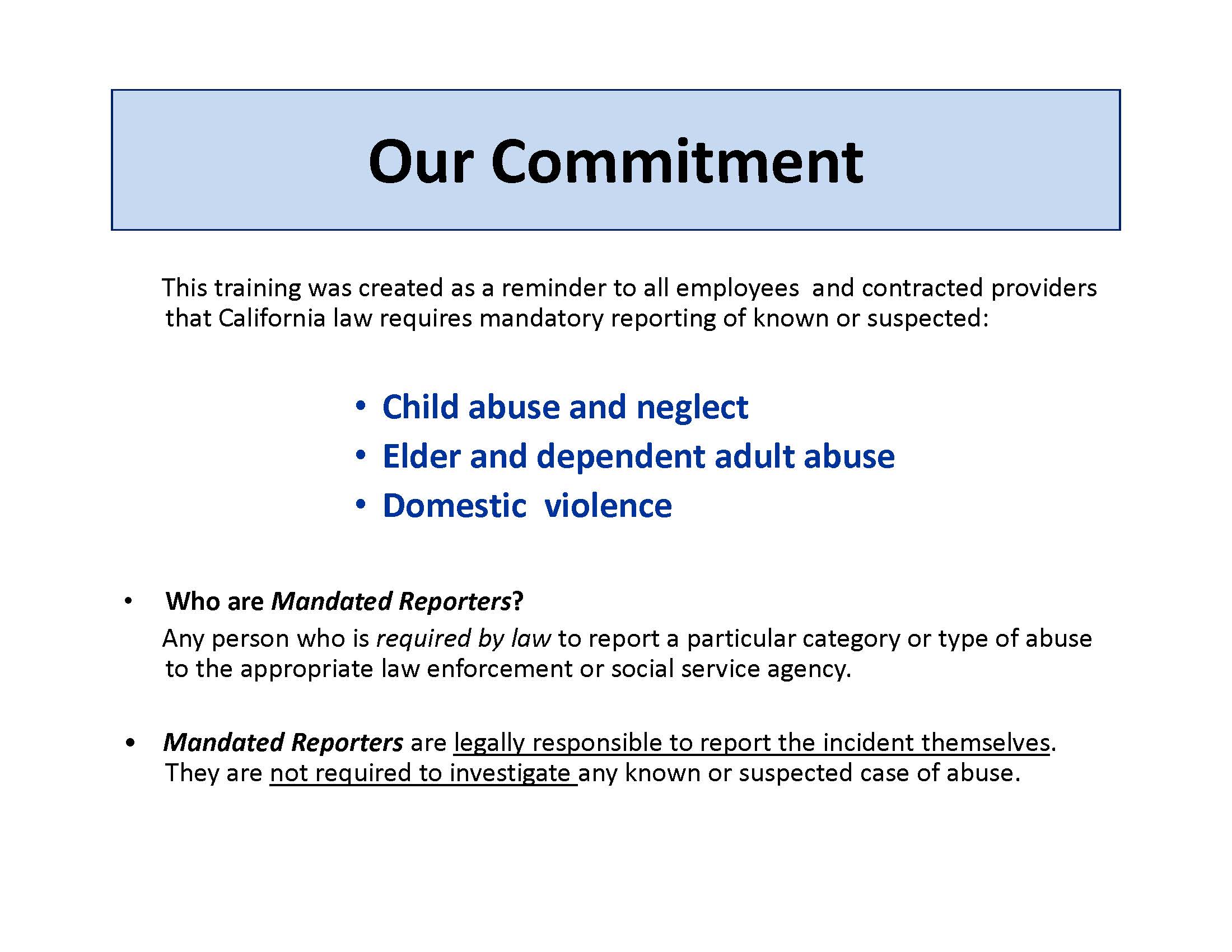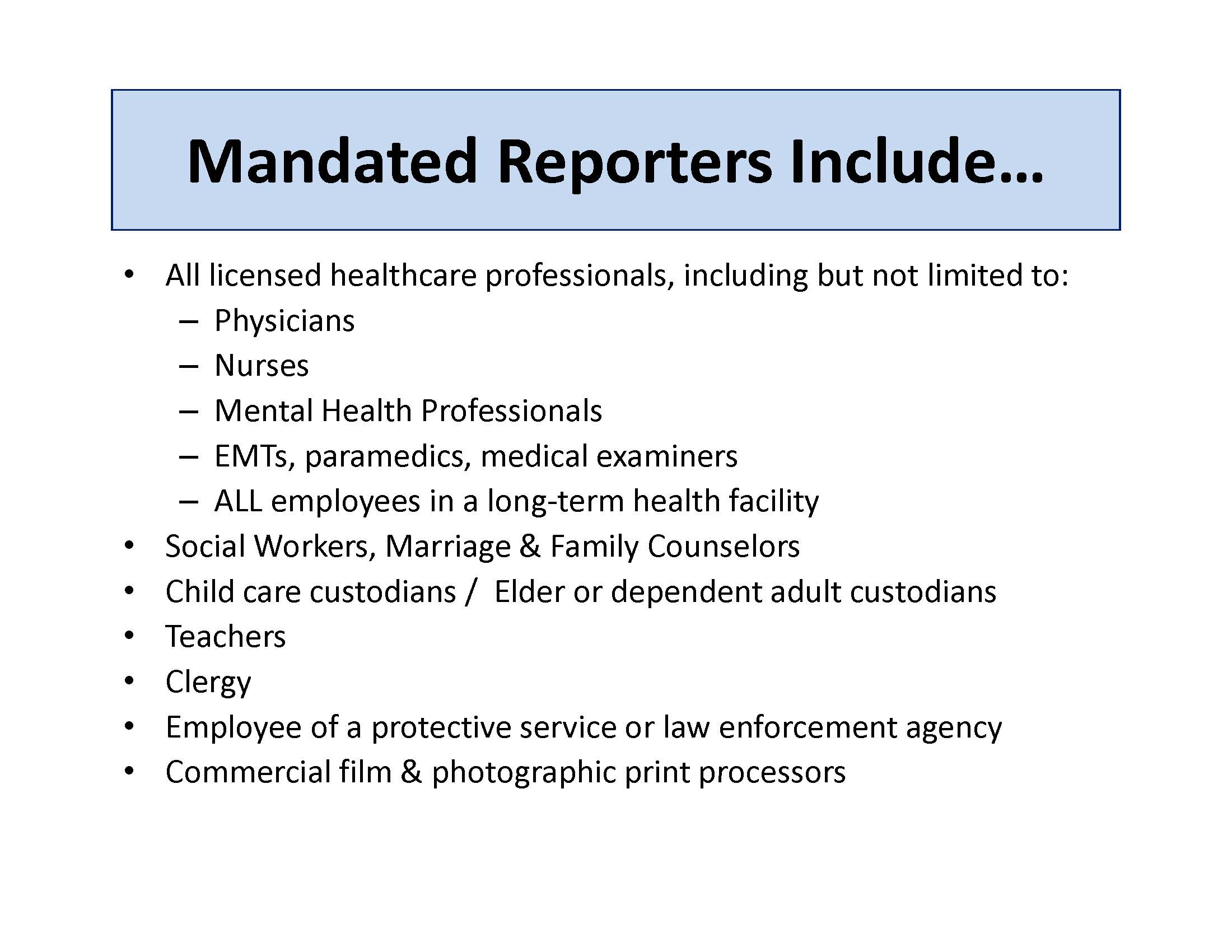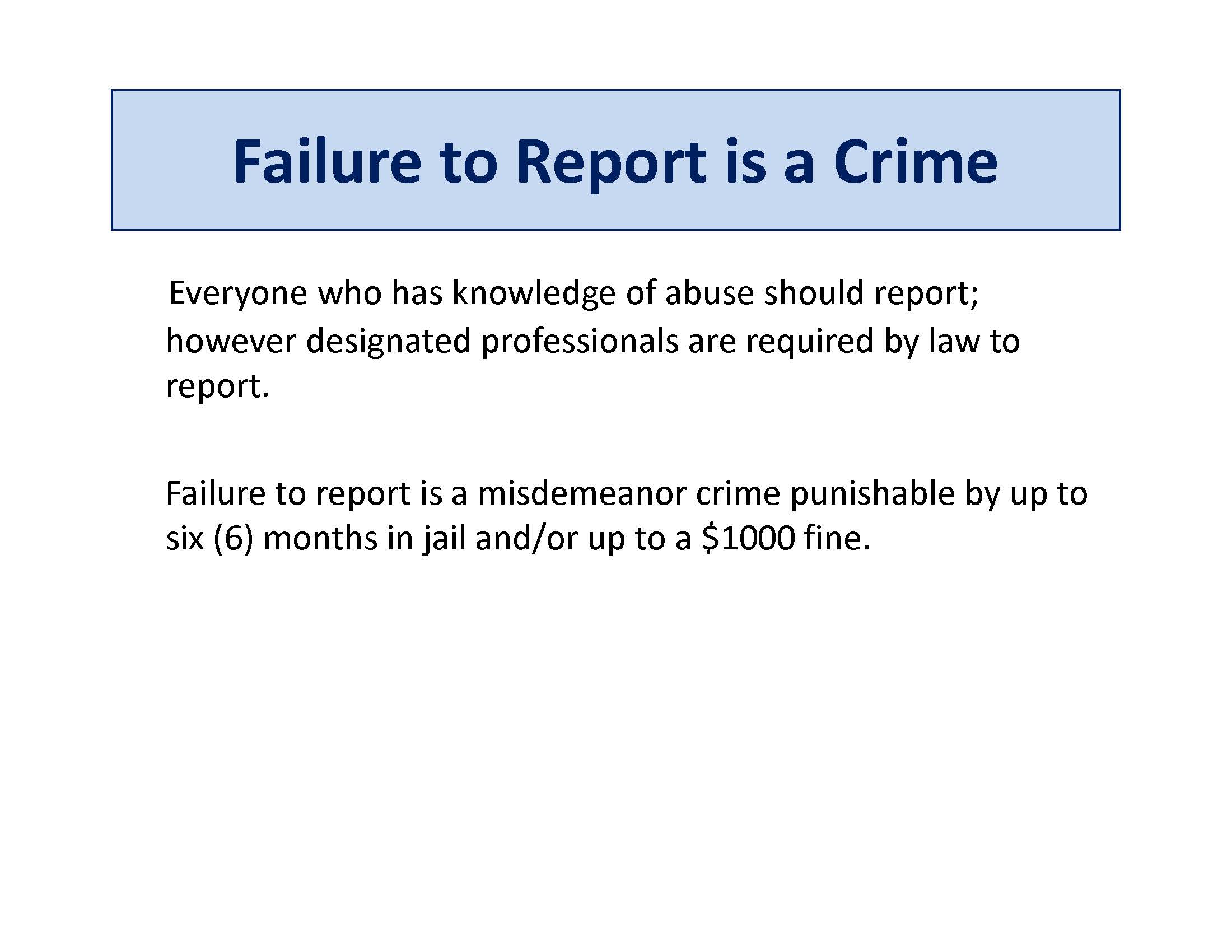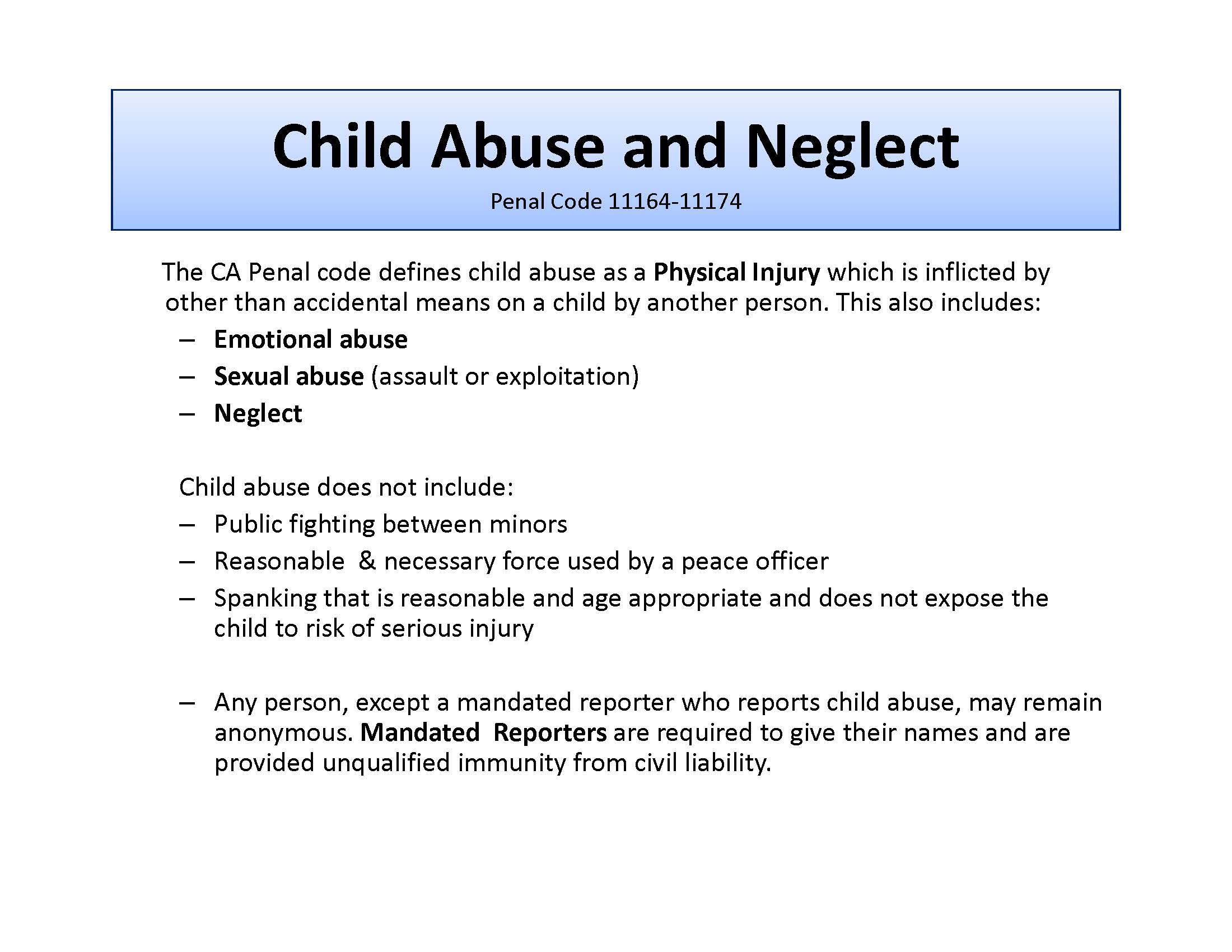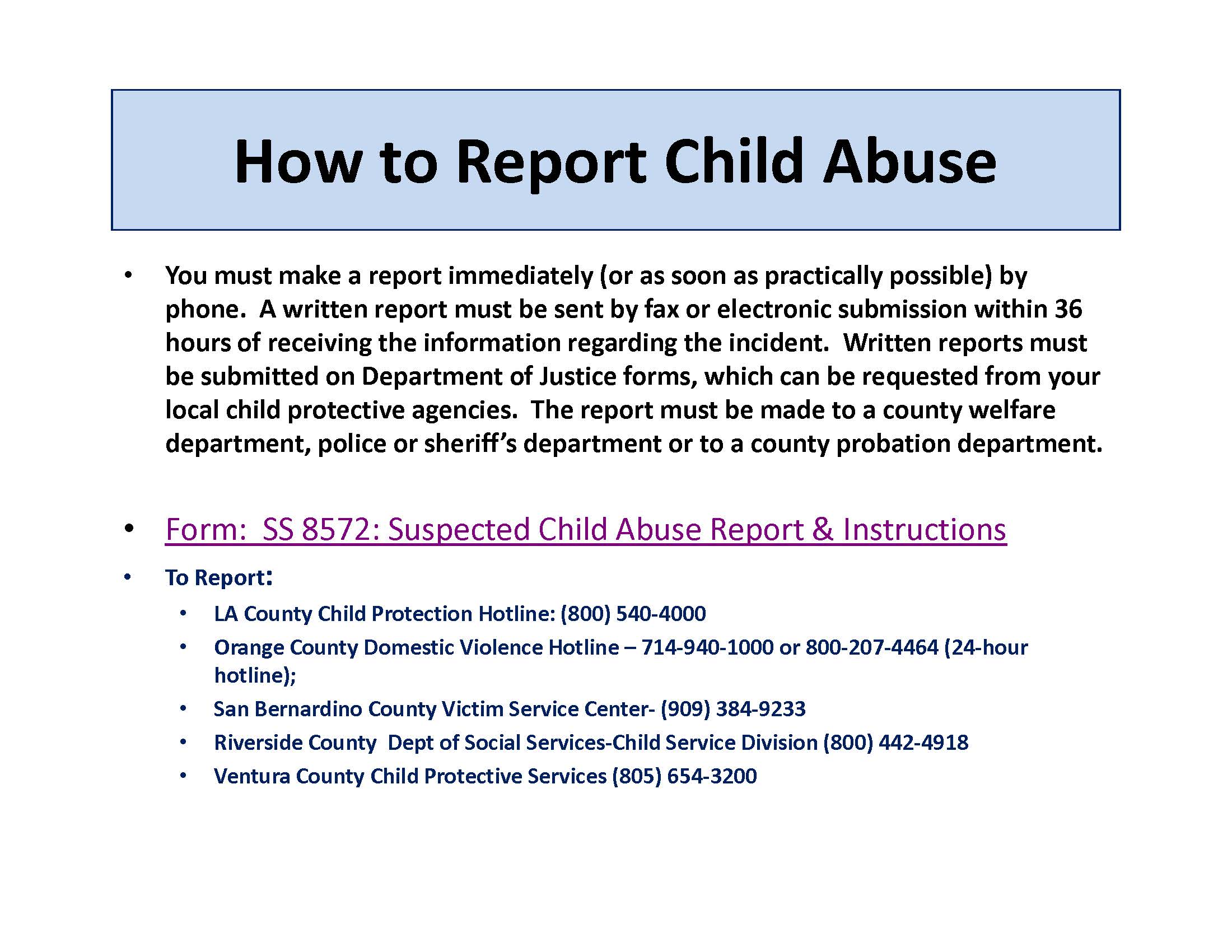California Child Abuse and Neglect Reporting Law
Mandatory Reporters of Abuse and Neglect of Children

Children’s Bureau/ACYF/ACF/HHS
800.394.3366 | Email: info@childwelfare.gov | https://www.childwelfare.gov
STATE STATUTES
Current Through April 2019
WHAT’S INSIDE
Professionals required to report Reporting by other persons Institutional responsibility to report Standards for making a report Privileged communications Inclusion of the reporter’s name in the report Disclosure of the reporter’s identity Summaries of State laws To find statute information for a particular State, go to https://www.childwelfare.gov/topics/systemwide/laws-policies/state/.
Mandatory Reporters of Child Abuse and Neglect The Federal Child Abuse Prevention and Treatment Act (CAPTA) requires each State to have provisions or procedures for requiring certain individuals to report known or suspected instances of child abuse and neglect.1 For this publication, information regarding mandatory reporting laws was collected for all States. The results indicate that all States, the District of Columbia, American Samoa, Guam, the Northern Mariana Islands, Puerto Rico, and the U.S. Virgin Islands identify in statute the professionals and other persons who are required to report instances of suspected child maltreatment. These statutes also address reporting by other persons, the responsibilities of institutions in making reports, standards for making a report, and confidentiality of the reporter’s identity.1 42 U.S.C. § 106a(b)(2)(B)(i) Mandatory Reporters of Child Abuse and Neglect https://www.childwelfare.gov
you can learn more here Mandatory Reporters of Abuse and Neglect of Children kids
California Child Abuse and Neglect Reporting Law
Dear Colleagues,
We are pleased to share this joint letter from the California Department of Social Services, the California Department of Health Care Services, and the Office of the California Surgeon General
providing clarifying guidance on the responsibilities of health care clinical teams who conduct screenings for Adverse Childhood Experiences (ACEs) in the context of the state’s mandated
reporting requirements.
The Child Abuse and Neglect Reporting Act requires individuals that fall into the category of a “mandated reporter” to report suspected child abuse or neglect to Child Protective Services.
Mandated reporters are professionals who have regular contact with children or are otherwise in a position to observe indicators of abuse and are, therefore, legally required to report
suspected child abuse. In California there are 49 categories of individuals defined as mandated reporters. There are also professionals that are required to report abuse of elders (65 or older)
and dependent adults (18 or older with a disability), but those requirements are not discussed in this document.
The Office of the California Surgeon General (CA-OSG) and the Department of Health Care Services (DHCS) jointly launched the ACEs Aware initiative on January 1, 2020, with the goal of
providing training, clinical protocols, and payment to Medi-Cal providers for screening children and adults for Adverse Childhood Experience (ACEs). Since the initiative launched, several
questions have emerged about the interaction between ACE screening and the requirement that health and mental health care clinical teams report suspected cases of child abuse and/or
neglect to Child Protective Services for investigation. This document is designed to provide information to the health care community, local governments, and other interested stakeholders in hopes of clarifying these issues.
Mandated Reporter Laws
Child Abuse Identification & Reporting Guidelines
Information for school personnel and those who work in our children’s schools to be able to identify signs of suspected cases of child abuse and/or child neglect and to have the tools to know how to make a report to the proper authorities.
These guidelines are issued by the California Department of Education (CDE), in conjunction with the California Department of Social Services, to help all persons, particularly those persons who work in our children’s schools, to be able to identify signs of suspected cases of child abuse and/or child neglect and to have the tools to know how to make a report to the proper authorities. These guidelines are issued in conjunction with an extensive training module, specifically aimed at training school employees and educators on their obligations as mandated reporters of child abuse, which can be located online at California Child Abuse Mandated Reporter Training ![]() .
.
Identification of Child Abuse and Neglect
Child abuse is more than bruises or broken bones. While physical abuse often leaves visible scars, not all child abuse is as obvious, but can do just as much harm. It is important that individuals working with and around children be able to know what constitutes child abuse or child neglect and know how to identify potential signs.
Child Abuse and/or Child Neglect Can Be Any of the Following:
- A physical injury inflicted on a child by another person other than by accidental means.
- The sexual abuse, assault, or exploitation of a child.
- The negligent treatment or maltreatment of a child by a person responsible for the child’s welfare under circumstances indicating harm or threatened harm to the child’s health or welfare. This is whether the harm or threatened harm is from acts or omissions on the part of the responsible person.
- The willful harming or endangerment of the person or health of a child, any cruel or inhumane corporal punishment or any injury resulting in a traumatic condition.
One does not have to be physically present or witness the abuse to identify suspected cases of abuse, or even have definite proof that a child may be subject to child abuse or neglect. Rather, the law requires that a person have a “reasonable suspicion” that a child has been the subject of child abuse or neglect. Under the law, this means that it is reasonable for a person to entertain a suspicion of child abuse or neglect, based upon facts that could cause a reasonable person, in a like position, drawing, when appropriate, on his or her training and experience, to suspect child abuse or neglect.
Red flags for abuse and neglect are often identified by observing a child’s behavior at school, recognizing physical signs, and observations of dynamics during routine interactions with certain adults. While the following signs are not proof that a child is the subject of abuse or neglect, they should prompt one to look further.
Warning Signs of Emotional Abuse in Children
- Excessively withdrawn, fearful, or anxious about doing something wrong.
- Shows extremes in behavior (extremely compliant or extremely demanding; extremely passive or extremely aggressive).
- Doesn’t seem to be attached to the parent or caregiver.
- Acts either inappropriately adult-like (taking care of other children) or inappropriately infantile (rocking, thumb-sucking, throwing tantrums).
Warning Signs of Physical Abuse in Children
- Frequent injuries or unexplained bruises, welts, or cuts.
- Is always watchful and “on alert” as if waiting for something bad to happen.
- Injuries appear to have a pattern such as marks from a hand or belt.
- Shies away from touch, flinches at sudden movements, or seems afraid to go home.
- Wears inappropriate clothing to cover up injuries, such as long-sleeved shirts on hot days.
Warning Signs of Neglect in Children
- Clothes are ill-fitting, filthy, or inappropriate for the weather.
- Hygiene is consistently bad (unbathed, matted and unwashed hair, noticeable body odor).
- Untreated illnesses and physical injuries.
- Is frequently unsupervised or left alone or allowed to play in unsafe situations and environments.
- Is frequently late or missing from school.
Warning Signs of Sexual Abuse in Children
- Trouble walking or sitting.
- Displays knowledge or interest in sexual acts inappropriate to his or her age, or even seductive behavior.
- Makes strong efforts to avoid a specific person, without an obvious reason.
- Doesn’t want to change clothes in front of others or participate in physical activities.
- A sexually transmitted disease (STD) or pregnancy, especially under the age of fourteen.
- Runs away from home.
Reporting Child Abuse or Neglect
Community members have an important role in protecting children from abuse and neglect. While not mandated by law to do so, if child abuse or neglect is suspected, a report should be filed with qualified and experienced agencies that will investigate the situation. Examples of these agencies are listed below. Parents and guardians of pupils have the right to file a complaint against anyone they suspect has engaged in abuse or neglect of a child. Community members do not need to provide their name when making a report of child abuse or neglect. Telephone numbers for each county’s emergency response for child abuse reporting are located at California Emergency Response Child Abuse Reporting Telephone Numbers ![]() (PDF).
(PDF).
School volunteers, while not mandated reporters, should also be encouraged to report any suspected cases of abuse and neglect. Additionally, school volunteers are highly encouraged by the law to have training in the identification and reporting of child abuse and neglect. The training offered online to mandated reporters, is equally available to school volunteers.
Obligations of Mandated Reporters
A list of persons whose profession qualifies them as “mandated reporters” of child abuse or neglect is found in California Penal Code Section 11165.7. The list is extensive and continues to grow. It includes all school/district employees, administrators, and athletic coaches. All persons hired into positions included on the list of mandated reporters are required, upon employment, to be provided with a statement, informing them that they are a mandated reporter and their obligations to report suspected cases of abuse and neglect pursuant to California Penal Code Section 11166.5.
All persons who are mandated reporters are required, by law, to report all known or suspected cases of child abuse or neglect. It is not the job of the mandated reporter to determine whether the allegations are valid. If child abuse or neglect is reasonably suspected or if a pupil shares information with a mandated reporter leading him/her to believe abuse or neglect has taken place, the report must be made. No supervisor or administrator can impede or inhibit a report or subject the reporting person to any sanction.
To make a report, an employee must contact an appropriate local law enforcement or county child welfare agency, listed below. This legal obligation is not satisfied by making a report of the incident to a supervisor or to the school. An appropriate law enforcement agency may be one of the following:
- A Police or Sheriff’s Department (not including a school district police department or school security department).
- A County Probation Department, if designated by the county to receive child abuse reports.
- A County Welfare Department/County Child Protective Services.
The report should be made immediately over the telephone and should be followed up in writing. The law enforcement agency has special forms for this purpose that they will ask you to complete. If a report cannot be made immediately over the telephone, then an initial report may be made via e-mail or fax. A report may also be filed at the same time with your school district or county office of education (COE). School districts and COEs, however, do not investigate child abuse allegations, nor do they attempt to contact the person suspected of child abuse or neglect.
School districts and COEs may have additional policies adopted at the local level relating to the duties of mandated reporters. School staff should consult with their district to determine if there are additional steps that must be taken.
These policies do not take the place of reporting to an appropriate local law enforcement or county child welfare agency.
New Required Training for School Employees
Effective January 1, 2015, Assembly Bill 1432 (D-Gatto) requires all local educational agencies (LEAs) to train all employees each year on what they need to know in order to identify and report suspected cases of child abuse and neglect. “All employees” includes anybody working on the LEA’s behalf, such as teachers, teacher’s aides, classified employees, and any other employees whose duties bring them into direct contact and supervision of students. LEAs must also develop a process to provide proof that employees received training. An online training module has been developed specially for educators and is located at California Child Abuse Mandated Reporter Training ![]() . Alternative training methods may be used but, if an LEA uses training other than the online training module, the LEA must report that fact to the CDE and inform the CDE of the training that was used. A form for this purpose is available at Reporting Form for LEAs Who Use Alternative Training For Mandatory Reporting (PDF).
. Alternative training methods may be used but, if an LEA uses training other than the online training module, the LEA must report that fact to the CDE and inform the CDE of the training that was used. A form for this purpose is available at Reporting Form for LEAs Who Use Alternative Training For Mandatory Reporting (PDF).
Rights to Confidentiality and Immunity
Mandated reporters are required to give their names when making a report. However, the reporter’s identity is kept confidential. Reports of suspected child abuse are also confidential. Mandated reporters have immunity from state criminal or civil liability for reporting as required. This is true even if the mandated reporter acquired the knowledge, or suspicion of the abuse or neglect, outside his/her professional capacity or scope of employment.
Consequences of Failing to Report
A person who fails to make a required report is guilty of a misdemeanor punishable by up to six months in jail and/or up to a $1,000 fine (California Penal Code Section 11166[c]).
After the Report is Made
The local law enforcement agency is required to investigate all reports. Cases may also be investigated by Child Welfare Services when allegations involve abuse or neglect within families.
Child Protective Services
The Child Protective Services (CPS) is the major organization to intervene in child abuse and neglect cases in California. Existing law provides for services to abused and neglected children and their families. More information can be found at Child Protective Services.
California Child Abuse and Neglect Reporting Law
Greater Bay Area Child Abuse Prevention Council Coalition The first child abuse reporting law in California was enacted in 1963.
That early law mandated only physicians to report physical abuse. Over the years, numerous amendments have expanded the definition of reportable child abuse and the persons required to report it. It is important for mandated reporters to keep updated on periodic amendments to the law.Your local Child Abuse Prevention Council or county welfare department has current reporting law information. Also visit www.leginfoca.gov for updated information on the law and any other code section referenced in this material. The California Child Abuse and Neglect Reporting Law is currently found in Penal Code (P.C.) Sections 11164 – 11174.3. The following is only a partial description of the law. Mandated reporters should become familiar with the detailed requirements as they are set forth in the Penal Code.
Who Are Mandated Reporters? P.C. 11165.7 defines “mandated reporters” as any of the following:
-
- 1) A teacher.
- 2) An instructional aide.
- 3) A teacher’s aide or a teacher’s assistant employed by any public or private school.
- 4) A classified employee of any public school.
- 5) An administrative officer or supervisor of child welfare and attendance, or a certificated pupil personnel employee of any public or private school.
- 6) An administrator of a public or private day camp.
- 7) An administrator or employee of a public or private youth center, youth recreation program, or youth organization.
- 8) An administrator or employee of a public or private organization whose duties require direct contact and supervision of children.
- 9) Any employee of a county office of education or the California Department of Education, whose duties bring the employee into contact with children on a regular basis.
- 10) A licensee, an administrator, or an employee of a licensed community care or child day care facility. California Child Abuse and Neglect Reporting Law
- 11) A Head Start program teacher.
- 12) A licensing worker or licensing evaluator employed by a licensing agency as defined in P.C. 11165.11.
- 13) A public assistance worker.
- 14) An employee of a child care institution including, but not limited to, foster parents, group home personnel, and personnel of residential care facilities.
- 15) A social worker, probation officer, or parole officer.
- 16) An employee of a school district police or security department.
- 17) Any person who is an administrator or presenter of, or a counselor in, a child abuse prevention program in any public or private school.
- 18) A district attorney investigator, inspector, or local child support agency caseworker unless the investigator, inspector, or caseworker is working with an attorney appointed pursuant to Section 317 of the Welfare and Institutions Code to represent a minor.
- 19) A peace officer, as defined in Chapter 4.5 (commencing with Section 830) of Title 3 of Part 2 of the Penal Code, who is not otherwise described in P.C. 11165.7.
- 20) A firefighter, except for volunteer firefighters.
- 21) A physician, surgeon, psychiatrist, psychologist, dentist, resident, intern, podiatrist, chiropractor, licensed nurse, dental hygienist, optometrist, marriage, family and child counselor, clinical social worker, or any other person who is currently licensed under Division 2 (commencing with Section 500) of the Business and Professions Code.
- 22) Any emergency medical technician I or II, paramedic, or other person certified pursuant to Division 2.5 (commencing with Section 1797) of the Health and Safety Code.
- 23) A psychological assistant registered pursuant to Section 2913 of the Business and Professions Code.
- 24) A marriage, family and child therapist trainee, as defined in subdivision (c) of Section 4980.03 of the Business and Professions Code.
- 25) An unlicensed marriage, family, and child therapist intern registered under Section 4980.44 of the Business and Professions Code.
- 26) A state or county public health employee who treats a minor for venereal disease or any other condition.
- 27) A coroner.
- 28) A medical examiner, or any other person who performs autopsies.
- 29) A commercial film and photographic print processor, as specified in subdivision (e) of P.C. 11166. For purposes of the California Child Abuse Reporting Law, “commercial film and photographic print processor” means any person who develops exposed photographic film into negatives, slides, or prints, or who makes prints from negatives or slides, for compensation. The term includes any employee of such a person; it does not include a person who develops film or makes prints for a public agency.
- 30) A child visitation monitor. For purposes of the California Child Abuse Reporting Law, “child visitation monitor” means any person who, for financial compensation, acts as monitor of a visit between a child and any other person when the monitoring of that visit has been ordered by acourt of law.
- 31) An animal control officer or humane society officer. For purposes of the California Child Abuse Reporting Law, the following terms have the following meanings:
- (A) “Animal control officer” means any person employed by a city, county, or city and county for the purpose of enforcing animal control laws and regulations.
- (B) “Humane society officer” means any person appointed or employed by a public or private entity as a humane officer who is qualified pursuant to Section 14502 or 14503 of the Corporations Code.
- 32) A clergy member, as specified in subdivision (d) of P.C. 11166. For purposes of the California Child Abuse Reporting Law, “clergy member” means a priest, minister, rabbi, religious practitioner, or similar functionary of a church, temple, or recognized denomination or organization.
- 33) Any custodian of records of a clergy member, as specified in P.C.11165.7 and subdivision (d) of Section 11166.
- 34) Any employee of any police department, county sheriff’s department, county probation department, or county welfare department.
- 35) An employee or volunteer of a Court Appointed Special Advocate program, as defined in Rule 1424 of the Rules of the Court.
- 36) A custodial officer as defined in Section 831.5 of the Penal Code.
- 37) Any person providing services to a minor child under Section 12300 or 12300.1 of the Welfare and Institutions Code.
- 38) An “alcohol and drug counselor” is a person providing counseling, therapy, or other clinical services for a licensed or certified drug, alcohol, or drug and alcohol treatment program. However, alcohol or drug abuse, or both alcohol and drug abuse, is not in and of itself a sufficient basis for reporting child abuse or neglect.
- 39) A clinical counselor trainee, as defined in subsection (g) of Section 4999.12 of the Business and Professions Code.
- 40) A clinical counselor intern registered under Section 4999.42 of the Business and Professions Code.
- 41) An employee or administrator of a public or private postsecondary institution, whose duties bring the administrator or employee into contact with children on a regular basis, or who supervises those whose duties bring the administrator or employee into contact with children on a regular basis, as to child abuse or neglect occurring on that institution’s premises or at an official activity of, or program conducted by, the institution. Nothing in this paragraph shall be construed as altering the lawyer-client privilege as set forth in Article 3 (commencing with Section 950) of Chapter 4 of Division 8 of the Evidence Code.
- 42) An athletic coach, athletic administrator, or athletic director employed by any public or private school that provides any combination of instruction for kindergarten, or grades 1 to 12, inclusive.
- 43)
- (A) A commercial computer technician as specified in subdivision (e) of Section 11166. As used in the article, “commercial computer technician” means a person who works for a company that is in the business of repairing, installing, or otherwise servicing a computer or computer component, including, but not limited to, a computer part, devise, memory storage or recording mechanism, auxiliary storage recording or memory capacity, or any other material relating to the operation and maintenance of a computer or computer network system, for a fee. An employer who provides an electronic communication service or a remote computing service to the public shall be deemed to comply with this Article if that employer complies with Section 2258A of Title 18 of the United States Code.
- (B) An employer of a commercial computer technician may implement internal procedures for facilitating reporting consistent with this article. These procedures may direct employees who are mandated reporters under this paragraph to report materials described in the subdivision (e) of Section 11166 to an employee who is designated by the employer to receive the reports. An employee who is designated to receive reports under this subparagraph shall be a commercial computer technician for the purposes of this article. A commercial computer technician who makes a report to the designated employee pursuant to this subparagraph shall be deemed to have complied with the requirements of this article and shall be subject to the protections afforded to mandated reporters, including, but not limited to, those protections afforded by Section 11172.
- 44) Any athletic coach, including but not limited to, an assistant coach or a graduate assistant involved in coaching, at public or private postsecondary institutions. NOTE: Unless otherwise stated, volunteers are not mandated reporters.
- 44) Any athletic coach, including, but not limited to, an assistant coach or a graduate assistant involved in coaching, at public or private postsecondary educational institutions.
- 45) An individual certified by a licensed foster family agency as a certified family home, as defined in Section 1506 of the Health and Safety Code.
- 46) An individual approved as a resource family, as defined in Section 1517 of the Health and Safety Code and Section 16519.5 of the Welfare and Institutions Code.
- 47) A qualified autism service provider, a qualified autism service professional, or a qualified autism service paraprofessional, as defined in Section 1374.73 of the Health and Safety Code and Section 10144.51 of the Insurance Code.
- 48) A human resource employee of a business subject to Part 2.8 (commencing with Section 12900) of Division 3 of Title 2 of the Government Code that employs minors. For purposes of this section, a “human resource employee” is the employee or employees designated by the employer to accept any complaints of misconduct as required by Chapter 6 (commencing with Section 12940) of Part 2.8 of Division 3 of Title 2 of the Government Code.
- 49)
- (a) An adult person whose duties require direct contact with and supervision of minors in the performance of the minors’ duties in the workplace of a business subject to Part 2.8 (commencing with Section 12900) of Division 3 of Title 2 of the Government Code is a mandated reporter of sexual abuse, as defined in Section 11165.1. Nothing in this paragraph shall be construed to modify or limit the person’s duty to report known or suspected child abuse or neglect when the person is acting in some other capacity that would otherwise make the person a mandated reporter.
- (b) Except as provided in paragraph (35) of subdivision (a), volunteers of public or private organizations whose duties require direct contact with and supervision of children are not mandated reporters but are encouraged to obtain training in the identification and reporting of child abuse and neglect and are further encouraged to report known or suspected instances of child abuse or neglect to an agency specified in Section 11165.9.
- (c)
- (1) Except as provided in subdivision (d) and paragraph
- (2), employers are strongly encouraged to provide their employees who are mandated reporters with training in the duties imposed by this article. This training shall include training in child abuse and neglect identification and training in child abuse and neglect reporting. Whether or not employers provide their employees with training in child abuse and neglect identification and reporting, the employers shall provide their employees who are mandated reporters with the statement required pursuant to subdivision (a) of Section 11166.5. (2) Employers subject to paragraphs (48) and (49) of subdivision (a) shall provide their employees who are mandated reporters with training in the duties imposed by this article. This training shall include training in child abuse and neglect identification and training in child abuse and neglect reporting. The training requirement may be met by completing the general online training for mandated reporters offered by the Office of Child Abuse Prevention in the State Department of Social Services.
- (d) Pursuant to Section 44691 of the Education Code, school districts, county offices of education, state special schools and diagnostic centers operated by the State Department of Education, and charter schools shall annually train their employees and persons working on their behalf specified in subdivision (a) in the duties of mandated reporters under the child abuse reporting laws. The training shall include, but not necessarily be limited to, training in child abuse and neglect identification and child abuse and neglect reporting.
- (e)
- (1) On and after January 1, 2018, pursuant to Section 1596.8662 of the Health and Safety Code, a childcare licensee applicant shall take training in the duties of mandated reporters under the child abuse reporting laws as a condition of licensure, and a childcare administrator or an employee of a licensed child daycare facility shall take training in the duties of mandated reporters during the first 90 days when that administrator or employee is employed by the facility.
- (2) A person specified in paragraph (1) who becomes a licensee, administrator, or employee of a licensed child daycare facility shall take renewal mandated reporter training every two years following the date on which that person completed the initial mandated reporter training. The training shall include, but not necessarily be limited to, training in child abuse and neglect identification and child abuse and neglect reporting.
- (f) Unless otherwise specifically provided, the absence of training shall not excuse a mandated reporter from the duties imposed by this article.
- (g) Public and private organizations are encouraged to provide their volunteers whose duties require direct contact with and supervision of children with training in the identification and reporting of child abuse and neglect.
(Amended by Stats. 2020, Ch. 243, Sec. 1. (AB 1963) Effective January 1, 2021.)
Why Must You Report? The primary intent of the reporting law is to protect an abused child from further abuse. Protecting the identified child may also provide the opportunity to protect other children. It is equally important to provide help for the parents. Parents may be unable to ask for help directly, and child abuse may be their way of calling attention to family problems. The report of abuse may be a catalyst for bringing about change in the home environment, which in turn may help to lower the risk of abuse in the home. And lastly, it is the law.
What Do You Have To Report?
Under the law, when the victim is a child (a person under the age of 18) and the perpetrator is any person (including a child), the following types of abuse must be reported by all legally mandated reporters:
- A physical injury inflicted by other than accidental means upon a child. (P.C. 11165.6) Note that child abuse does not include a “mutual affray” between minors. It also does not include an injury caused by “reasonable and necessary force used by apeace officer acting within the course and scope of his or her employment.” (P.C. 11165.6)
- Sexual abuse of a child, including both sexual assault and sexual exploitation. “Sexual assault” includes sex acts with a child, lewd or lascivious acts with a child, and intentional masturbation in the presence of a child. “Sexual exploitation” includes preparing, selling, or distributing pornographic materials involving children; employing a minor to perform in pornography; and employing or coercing a child to engage in prostitution. (P.C. 11165.1)
- Willful harming or injuring of a child or the endangering of the person or health of a child, including inflicting or permitting unjustifiable physical pain or mental suffering. (P.C. 11165.3)
NOTE: Any mandated reporter may report any child who is suffering serious emotional damage or is at substantial risk of suffering serious emotional damage. (P.C. 11166.05) - Willful infliction of cruel or inhuman corporal punishment or injury resulting in a traumatic condition. (P.C. 11165.4)
- Neglect of a child, whether “severe” or “general,” by a person responsible for the child’s welfare. The term “neglect” includes both acts or omissions harming or threatening to harm thechild’s health or welfare. (P.C. 11165.2)
When Do You Have To Report?
Child abuse must be reported when a mandated reporter, “in his or her professional capacity or within the scope of his or her employment, has knowledge of or observes a child whom the mandated reporter knows or reasonably suspects has been the victim of child abuse or neglect.”
- (P.C. 11166 (a)) “Reasonable suspicion” occurs when “it is objectively reasonable for a person to entertain a suspicion, based upon facts that could cause a reasonable person in a like position, drawing, when appropriate, on his or her training and experience, to suspect child abuse or neglect.”
- (P.C. 11166 (a)(1)) Although wordy, the intent of this definition is clear: if you suspect that abuse has occurred, make a report. You must make a report immediately (or as soon as practicably possible) by phone and you must prepare and send, fax or electronically transmit a written report within 36 hours of receiving the information regarding the incident.
- (P.C. 11166 (a)) Written reports must be submitted on Department of Justice form (SS 8572), which can be downloaded from the California
Attorney General’s Website at www.oag.ca.gov ( or DOWNLOAD IT HEREForm SS 8572 pdf). The mandated reporter may include with the report any nonprivileged documentary evidence he or she possesses related to the incident. To Whom Must You Report? The report must be made to any police department or sheriff’s department (not including a school district police or security department),county probation department, if designated by the county to receive mandated reports, or county welfare department. - (P.C. 11165.9) Any mandated reporter who knows or reasonably suspects that the home or institution in which the child resides is unsuitable for the child because of abuse or neglect
shall inform the agency about the unsuitability of the home at the same time he or she reports the abuse or neglect. - (P.C. 11166 (f)) When two or more persons who are required to report jointly have knowledge of a known or suspected instance of child abuse or neglect, and when there is agreement among them, a single person from the group may make the report. Any group member who knows that the report was not made, however, shall make the report.
- (P.C. 11166 (h)) Immunity
- Mandated reporters have immunity from criminal and civil liability for any report required or authorized under the Child Abuse Reporting Law. This immunity applies even though the knowledge or reasonable suspicion of abuse was acquired outside his or her professional capacity or outside the scope of his or her employment.
- (P.C. 11172 (a)) And if a mandated reporter is sued for making a report, he or she may be able to receive compensation for legal fees incurred in defending against the action. (P.C. 11172 (c))
- Any person who makes a report of child abuse, even though he or she is not a mandated reporter, has immunity unless the report is proven to be false and it is proven that the person either knew the report was false or made it with reckless disregard of its truth or falsity.
- (P.C. 11172 (d) (1) Additional Safeguards for Mandated Reporters
No supervisor or administrator may impede or inhibit a mandated reporter’s reporting duties or subject the reporting person to any sanction for making a report. (P.C. 11166 (i)(1))
Any supervisor or administrator who violates the above cited code section is guilty of a misdemeanor punishable by a fine not to exceed one thousand dollars ($1,000), by not more than six months in a county jail, or by both a fine and imprisonment. - (P.C. 11166.01(a)) If however, death or great bodily injury happens to the child as a result of the abuse, the supervisor or administrator who impeded or inhibited the report is guilty of a misdemeanor punishable by not more than one year in county jail, by a fine not to exceed five thousand dollars ($5,000), or by both.
- (P.C. 11166.01(b)) The mandated reporter’s identity is confidential and may only be disclosed to specified persons and agencies.
- (P.C. 11167 (d)(1)) Mandated reporters and others acting at their direction are not liable civilly or criminally for photographing the victim and including the photograph with their report.
- (P.C. 11172 (a)) A clergy member who acquires knowledge or a reasonable suspicion of child abuse during a penitential communication is not mandated to report the abuse. For purposes of
the Child Abuse Reporting Law, “penitential communication” means communication, intended to be in confidence, including, but not limited to, a sacramental confessionmade to a clergy member. - (P.C. 11166 (d)(1)) Liability for Failure to Make A Required Report A mandated reporter who fails to make a required report of child abuse is guilty of a misdemeanor punishable by up tosix months in jail or by a $1,000 fine orby both a fine and imprisonment.
- (P.C. 11166 (c)) If however, death or great bodily injury happens to the child as a result of the abuse, or if the mandated reporter willfully fails to report the abuse the mandated reporter is guilty of a misdemeanor punishable by not more than one year in a county jail, by a fine not to exceed five thousand dollars ($5,000), or by both.
- (P.C. 11166.01 (b)) He or she may also be found civilly liable for damages, especially if the child-victim or another child is further victimized because of the failure to report. (Landeros v. Flood (1976) 17 Cal.3d 399.) If a mandated reporter conceals his or her failure to report abuse or “severe” neglect, the failure to report is a continuing offense until the failure is discovered by an agency specified in Section 11165.9.
- (P.C. 11166(c)) Because it is a continuing offense, the statute of limitations does not start to run until the failure to report is discovered.
- Responsibilities of Agencies Employing Mandated Reporters On and after January 1, 1985, with the exception of child visitation monitors, persons entering employment which make them mandated reporters must sign statements, provided and retained by their employers, informing them that they are mandated reporters and advising them of their reporting responsibilities and of their confidentiality rights.
- (P.C. 11166.5 (a)) On and after January 1, 1993, any person who acts as a child visitation monitor, prior to engaging in monitoring the first visit in a case, shall sign a statement provided and retained by the court which ordered the monitor’s presence to the effect that he or she has knowledge of the provisions of the Child Abuse Reporting Law and will comply with them.
- (P.C. 11166.5 (a)) Employers are strongly encouraged to provide their employees who are mandated reporters with training in the duties imposed by the Child Abuse Reporting Law. Training in the duties imposed by the reporting law shall include training in child abuse identification and reporting. Whether or not employers provide their employees with training, they shall provide their
employees who are mandated reporters with the statement required in subdivision (a) of Section 11166.5. - (P.C. 11165.7 (c)) The absence of training shall not excuse a mandated reporter from the duties imposed by the reporting law.
- (P.C. 11165.7 (e)) EXCEPTION: Any person providing services to a minor child under Section 12300 or 12300.1 of the Welfare and Institution Code shall not be require to make a child abuse report unless that person has received training, or instructional material in the appropriate language, on the duties imposed by the Child Abuse Reporting Law, including identifying and reporting abuse and neglect.
- (P.C. 11166.5 (e)) Feedback to Mandated Reporters
- Unless otherwise specifically provided, the investigation is completed or the matter reaches a final disposition, the investigating agency is obligated to inform the mandated reporter of the results of the investigation and any action the agency is taking with regards to the child or family.
- (P.C. 11170 (b)(2)) Please note that the California Child Abuse Reporting Law may have changed since the printing of this material. This material has been reprinted to assist mandated reporters in determining their reporting responsibilities. It is not intended to be and should not be considered legal advice. In the event there are questions about reporting responsibilities in a specific case, the advice of legal counsel should be sought. A special thank you to Delta Dental of California for their work in developing the original material.
www.safestate.org
Child Protective Services
The Child Protective Services is the major system of intervention of child abuse and neglect in California. Existing law provides for services to abused and neglected children and their families. The Child Protective Services goal is to keep the child in his/her own home when it is safe, and when the child is at risk, to develop an alternate plan as quickly as possible.
If you suspect that a child has been, or is in danger of, abuse or neglect , contact the county Children’s Protective Services 24-hour emergency response phone. You may also contact the police or county sheriff.
When a referral is received, the social service staff obtains facts from the person making the referral to determine if the referral alleges abuse, neglect, or exploitation. The Emergency Response staff determines if an in-person response is indicated. Whenever an report indicates the need for protection, Child Protective Services will:
- Accept the case
- Intervene in the crisis, if required
- Apply Family Preservation and Support Services for some families
- Assess or identify problems, gather facts and clarify the problems
- Plan and provide services, set goals, identify resources and timeframes
- Document the case
- Terminate the case or transfer it to another program
Approximately 12 months of services are provided to children who remain safely in the home while the family receives services. If it is determined that a child cannot remain in the home, even with family preservation and support services, then foster placement is arranged in the most family-like setting, that is located close to the parent’s home, consistent with the best interests of the child.
Up to 18 months of services are provided to children and their families when a child has been removed from the home and the family is making progress toward reunification. When a child cannot be returned to a safe home after services have been delivered, the child must be provided with a family-like living arrangement as soon as possible.
For Whom
These services are available to children and their families when children are victims of, or at risk of, abuse, neglect, exploitation, or parental absence. California law defines child abuse as any of the following:
- A child is physically injured by other than accidental means.
- A child is subjected to willful cruelty or unjustifiable punishment.
- A child is abused or exploited sexually.
- A child is neglected by a parent or caretaker who fails to provide adequate food, clothing, shelter, medical care or supervision.
Community members have an important role in protecting children from abuse and neglect. If abuse is suspected, a report should be filed with qualified and experienced agencies that will investigate the situation. The California State Child Abuse Reporting Law provides the legal basis for action to protect children and to allow intervention by public agencies if a child is being abused.

Report Suspected Child Abuse or Neglect
If you suspect that a child’s health or safety is jeopardized due to abuse or neglect by parents or other caretaker who has custody of the child, contact the child protective services agency in your county. These 24-hour Hotlines are staffed by trained social workers.
If you are reporting suspected child abuse or neglect regarding children in another county please contact that county’s child protective services agency.
California County Emergency Response Child Abuse Reporting Telephone Numbers
| Alameda County |
|
| Alpine County | (530)-694-2235 |
| Amador County | (209)-223-6550 – Mon thru Thurs 8:00-5:00 (209)-223-1075 – After hours |
| Butte County | (530)-538-7882 (800)-400-0902 – 24 hours |
| Calaveras County | (209)-754-6452 (209)-754-6500 – After hours |
| Colusa County | (530)-458-0280 |
| Contra Costa County |
|
| Del Norte County | (707)-464-3191 |
| El Dorado County | (530)-642-7100 – Placerville (530)-573-3201 – South Lake Tahoe |
| Fresno County | (559)-255-8320 |
| Glenn County | (530)-934-6520 (530)-934-6519 (530)-934-1429 – Intake |
| Humboldt County | (707)-445-6180 |
| Imperial County | (760)-337-7750 |
| Inyo County | (760)-872-1727 |
| Kern County | (661)-631-6011 (760)-375-6049 |
| Kings County | (559)-582-3241 – 8:00-5:00 (559)-582-8776 – After hours (866)-582-8776 |
| Lake County | (707)-262-0235 (800)-386-4090 |
| Lassen County | (530)-251-8277 (530)-257-6121 (530) 260-8131 – After hours |
| Los Angeles County | (800)-540-4000 – Within CA (213)-639-4500 – Outside CA (800)-272-6699 – TDD Online Reporting: https://reportChildAbuseLA.org |
| Madera County | (559)-675-7829 (800)-801-3999 |
| Marin County |
|
| Mariposa County | (209)-742-0900 – Daytime (209)-966-7000 – After hours |
| Mendocino County | (707)-463-7992 – Ukiah (707)-962-1100 – Fort Bragg (866)-263-0368 – Toll free |
| Merced County | (209)-385-3104 |
| Modoc County | (530)-233-6602 (866)-233-4424 |
| Mono County | (760)-924-1770 (760)-932-7549 – Sheriff Office (800)-340-5411 – Hot Line |
| Monterey County |
|
| Napa County |
|
| Nevada County | (530)-273-4291 – 24 hour |
| Orange County | (714)-940-1000 (800)-207-4464 |
| Placer County | (916)-872-6549 (866)-293-1940 |
| Plumas County | (530)-283-6300 – Sheriff Office (530)-283-6350 (800)-242-3338 – Toll free |
| Riverside County | (800)-442-4918 (877)-922-4453 |
| Sacramento County | (916)-875-5437 |
| San Benito County | (831)-636-4190 (831)-636-4330 – After hours Police |
| San Bernardino County | (909)-384-9233 (800)-827-8724 |
| San Diego County | (858)-560-2191 (800)-344-6000 |
| San Francisco County |
|
| San Joaquin County | (209)-468-1333 |
| San Luis Obispo County | (805)-781-5437 (800)-834-5437 |
| San Mateo County |
|
| Santa Barbara County | (800)-367-0166 |
| Santa Clara County |
|
| Santa Cruz County | (831)-454-2273 (877)-505-3299 |
| Shasta County | (530)-225-5144 |
| Sierra County | (530)-289-3720 (530)-993-6720 |
| Siskiyou County | (530)-841-4200 (530)-842-7009 – 24 hour hot line |
| Solano County |
|
| Sonoma County |
|
| Stanislaus County | (209)-558-3665 (800)-558-3665 |
| Sutter County | (530)-822-7227 |
| Tehama County | (530)-527-1911 (800)-323-7711 |
| Trinity County | (530)-623-1314 |
| Tulare County | (800)-331-1585 |
| Tuolumne County | (209)-533-5717 (209)-533-4357 – After hours |
| Ventura County | (805)-654-3200 |
| Yolo County | (530)-669-2345 (530)-669-2346 (888)-400-0022 – After hours |
| Yuba County | (530)-749-6288 |
Abuse & Neglect – The Reporters (Police, D.A & Medical & the Bad Actors)
If You Would Like to Learn More About: The California Mandated Reporting Law Click Here
To Read the Penal Code § 11164-11166 – Child Abuse or Neglect Reporting Act – California Penal Code 11164-11166 Article 2.5. (CANRA) Click Here
Mandated Reporter form Mandated Reporter FORM SS 8572.pdf – The Child Abuse
ALL POLICE CHIEFS, SHERIFFS AND COUNTY WELFARE DEPARTMENTS INFO BULLETIN Click Here Officers and DA’s for (Procedure to Follow)
It Only Takes a Minute to Make a Difference in the Life of a Child learn more below
You can learn more here California Child Abuse and Neglect Reporting Law its a PDF files taken from
https://mandatedreporterca.com/
SINCE YOU GUYS HAVE FAILED MAYBE YOU NEED PHONE NUMBERS
California Emergency Response Child Abuse Reporting Telephone Numbers
JUST IN CASE YOU ARE TOO DUMB TO DO YOU DUE DILLEGENCE HERE IS HOW YOU REPORT, YOU START WITH AN EDUCATION OF WHAT IT IS
https://goodshepherdmedia.net/mandated-reporter-laws/
JUST IN CASE YOU ARE TOO DUMB TO DO YOU DUE DILLEGENCE HERE IS HOW YOU REPORT… HINT, YOU HAVE TO FILE A FORM 🙂
Reporting Form for LEAs Who Use Alternative Training For Mandatory Reporting
MAYBE AS LAW MEN AND WOMEN YOU ARE INHERITNLY DONT CARE AND NOT BRUSHED UP ON LAW
Penal Code 288 PC – Lewd and Lascivious Acts with a Minor Child
Penal Code 288.2 PC- Sending Harmful Material to Seduce a Minor
Child Abuse Reporting Guidelines
capc.sccgov.org/child-abuse-reporting-guidelines
Myths and Facts About Sexual Assault
meganslaw.ca.gov/mobile/Education_MythsAndFacts.aspx
Where to report child sexual abuse
d2l.org/reporting-child-abuse-california/
YOU CAN READ THE IMAGES BELOW S OR DOWNLOAD THE PDF VERSION HERE
NEED THIS PENAL CODE 11164-11174 CLICK HERE Child Abuse & Neglect (YOU MUST MAKE A REPORT NO CHOICE)!
NEED THIS FORM ss_8572 CLICK HERE Suspected Child Abuse (YOU MUST MAKE A REPORT NO CHOICE)!
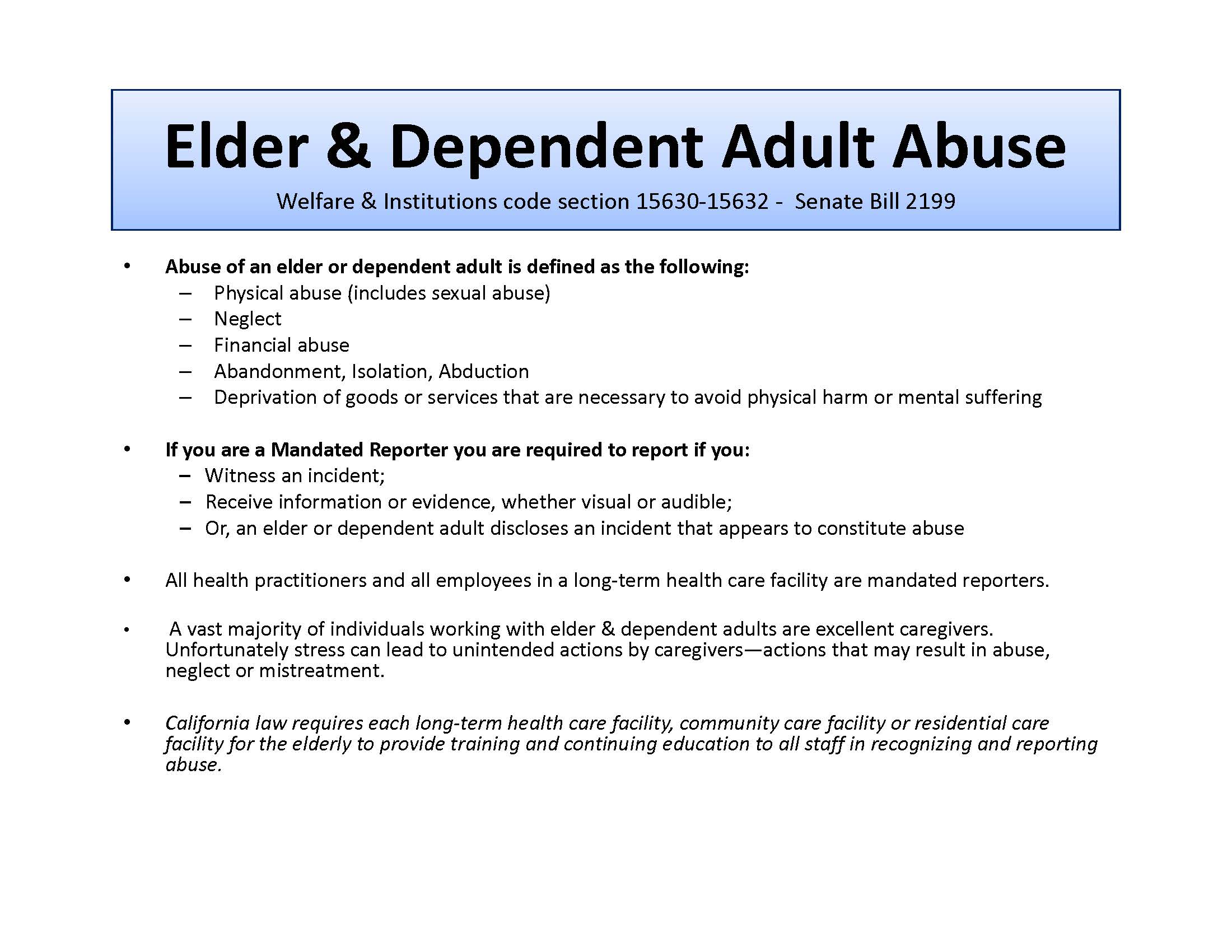
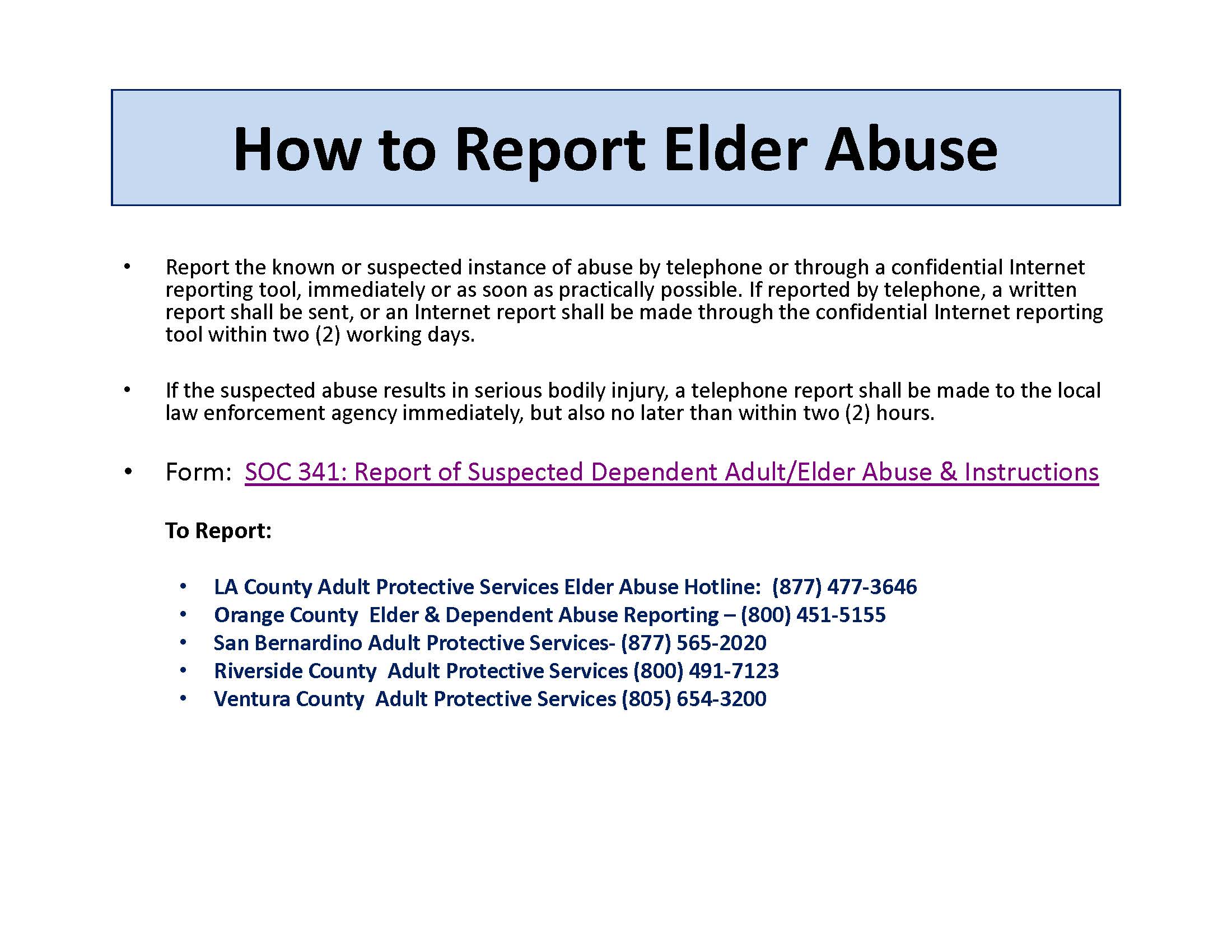
IN CASE YOU NEED THIS FORM SOC341A CLICK HERE


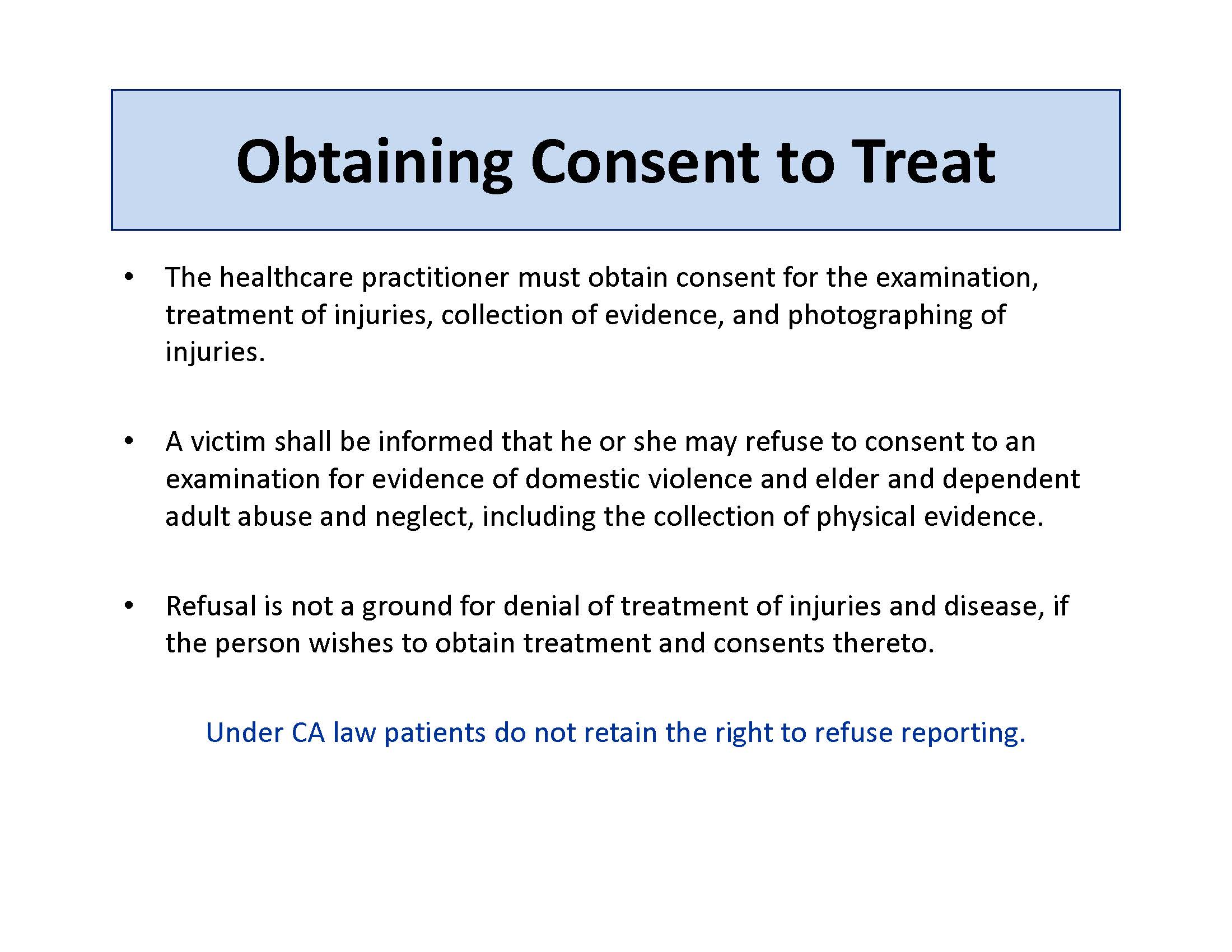
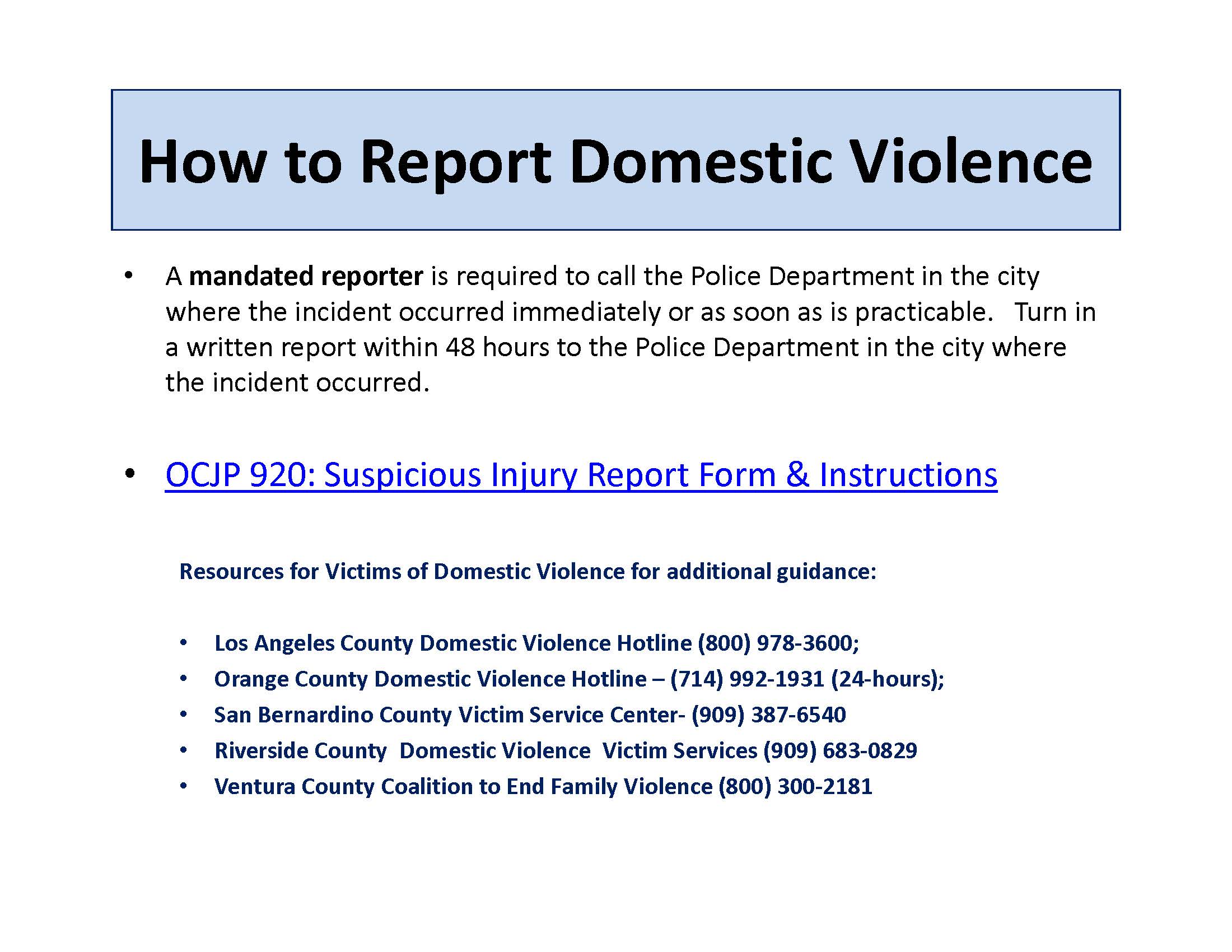
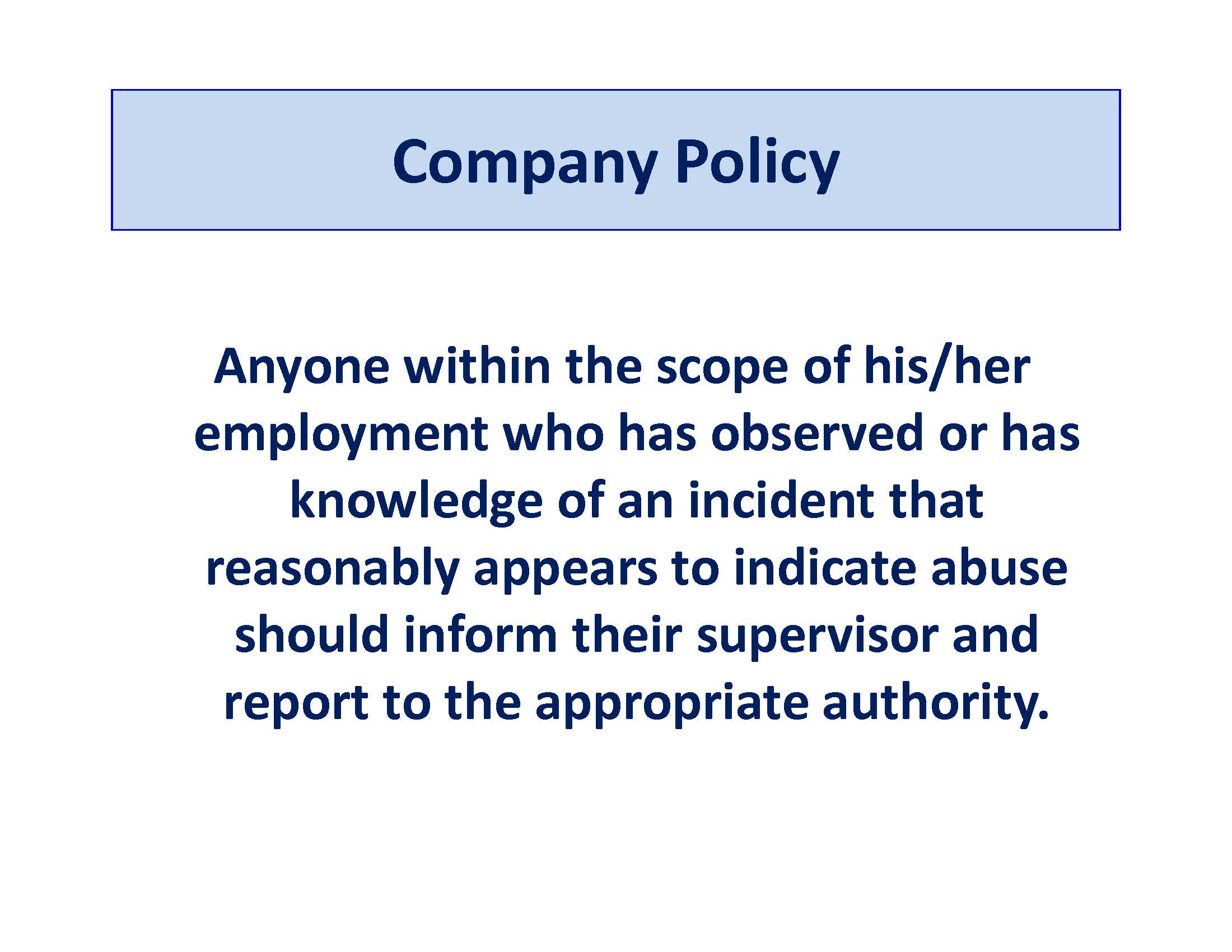
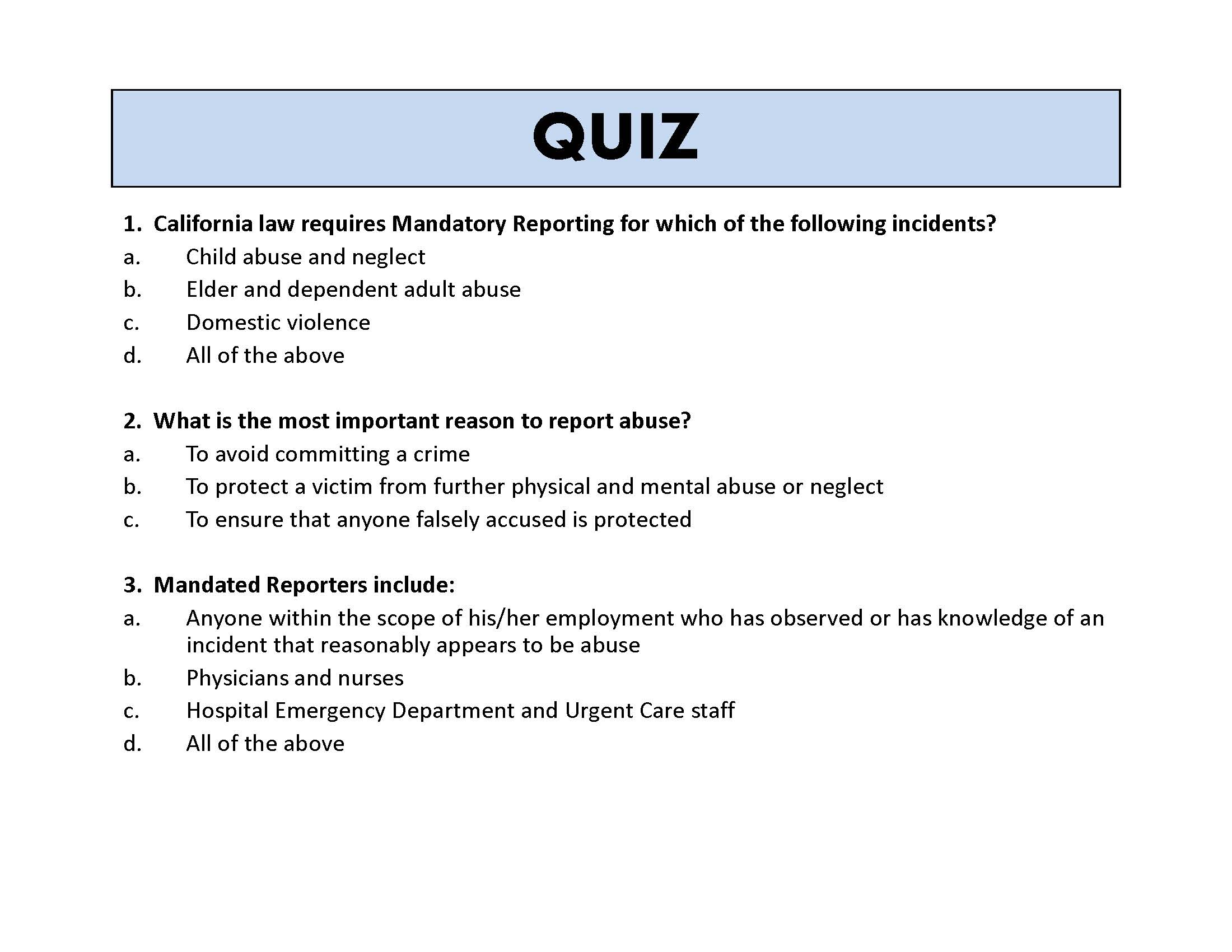
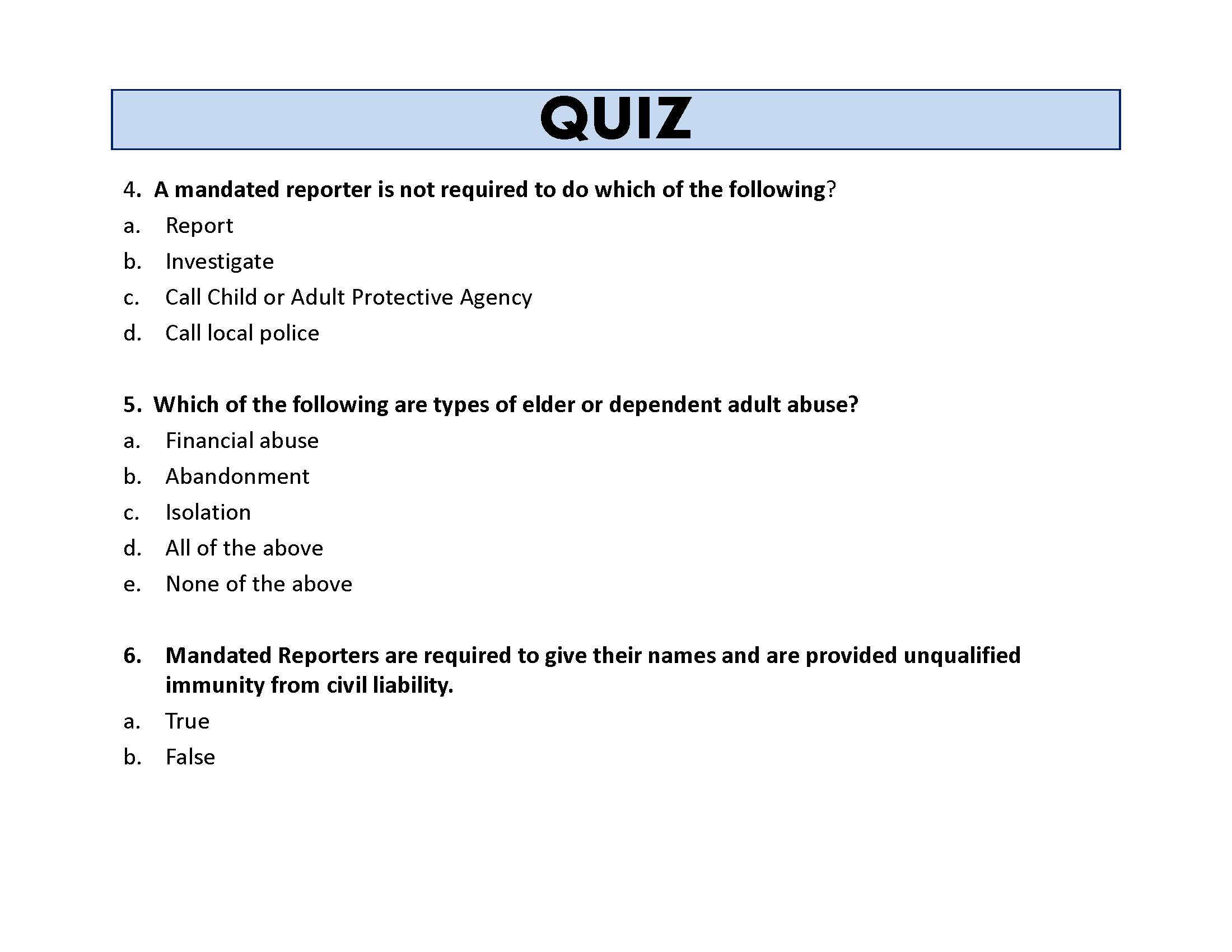
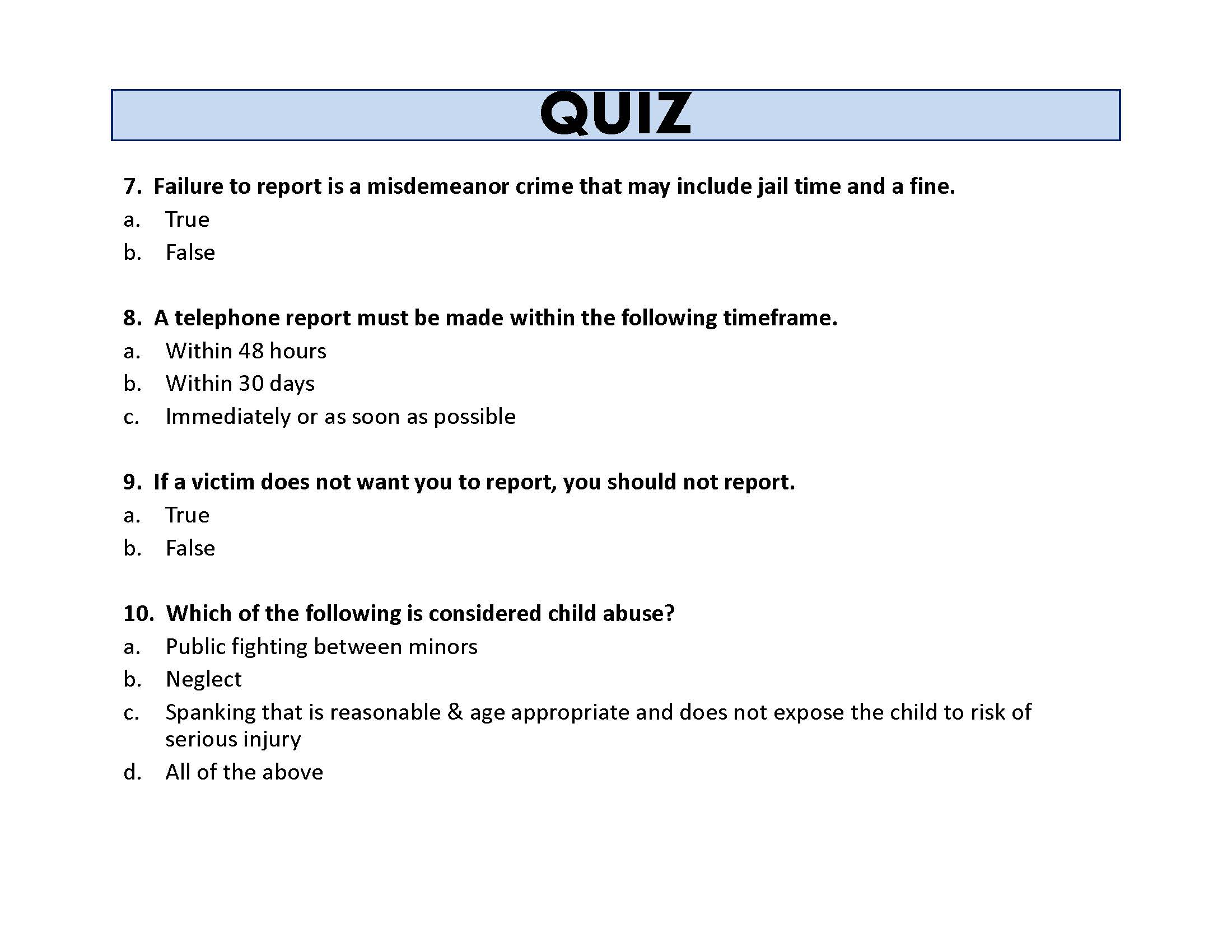
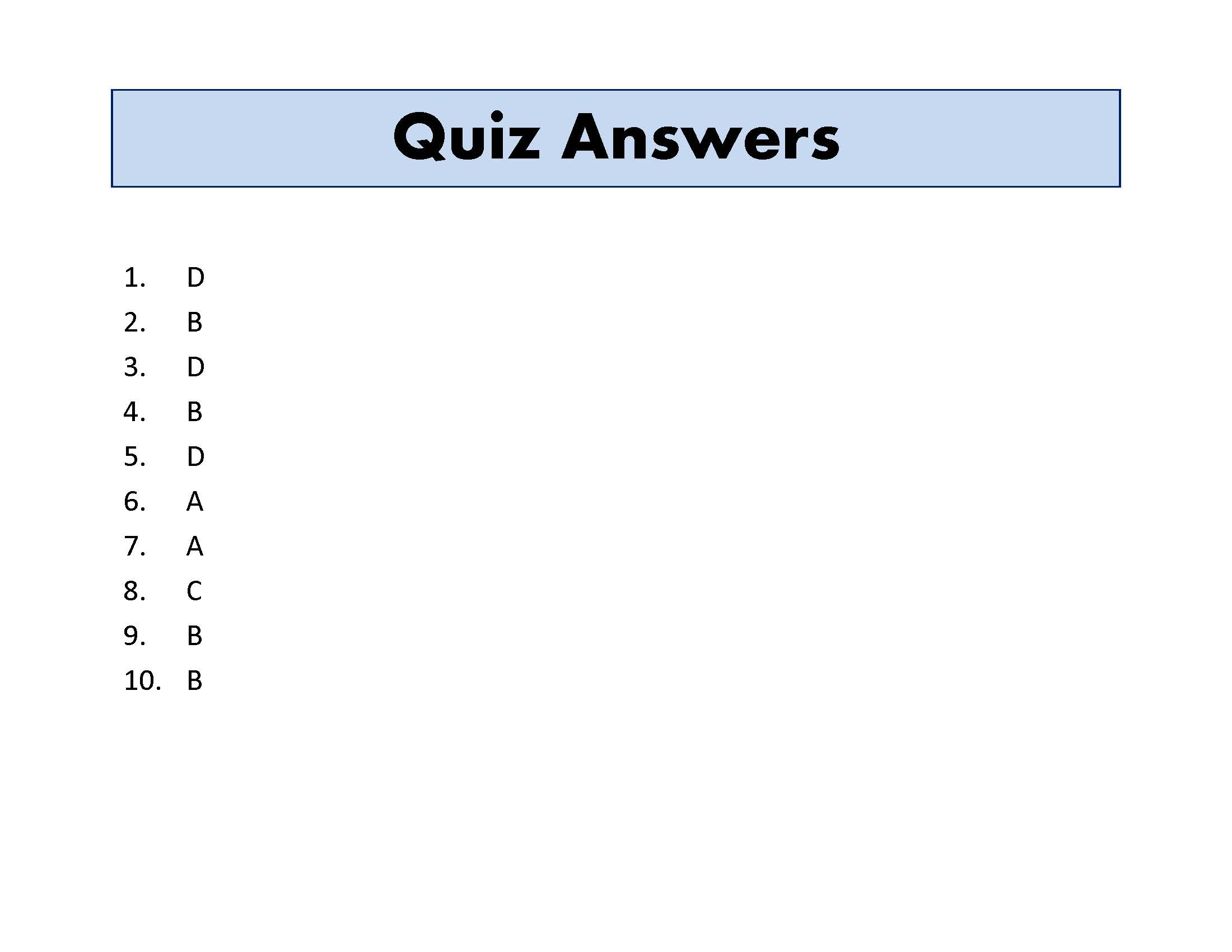
To Learn More…. Read MORE Below and click the links
Abuse & Neglect – The Reporters (Police, D.A & Medical & the Bad Actors)
If You Would Like to Learn More About: The California Mandated Reporting Law Click Here
To Read the Penal Code § 11164-11166 – Child Abuse or Neglect Reporting Act – California Penal Code 11164-11166Article 2.5. (CANRA) Click Here
Mandated Reporter formMandated Reporter FORM SS 8572.pdf – The Child Abuse
ALL POLICE CHIEFS, SHERIFFS AND COUNTY WELFARE DEPARTMENTS INFO BULLETIN Click Here Officers and DA’s for (Procedure to Follow)
It Only Takes a Minute to Make a Difference in the Life of a Child learn more below
You can learn more here California Child Abuse and Neglect Reporting Law its a PDF files taken from
https://mandatedreporterca.com/
SINCE YOU GUYS HAVE FAILED MAYBE YOU NEED PHONE NUMBERS
California Emergency Response Child Abuse Reporting Telephone Numbers
JUST IN CASE YOU ARE TOO DUMB TO DO YOU DUE DILLEGENCE HERE IS HOW YOU REPORT, YOU START WITH AN EDUCATION OF WHAT IT IS
https://goodshepherdmedia.net/mandated-reporter-laws/
JUST IN CASE YOU ARE TOO DUMB TO DO YOU DUE DILLEGENCE HERE IS HOW YOU REPORT… HINT, YOU HAVE TO FILE A FORM 🙂
Reporting Form for LEAs Who Use Alternative Training For Mandatory Reporting
MAYBE AS LAW MEN AND WOMEN YOU ARE INHERITNLY DONT CARE AND NOT BRUSHED UP ON LAW
Penal Code 288 PC – Lewd and Lascivious Acts with a Minor Child
Penal Code 288.2 PC- Sending Harmful Material to Seduce a Minor
Child Abuse Reporting Guidelines
capc.sccgov.org/child-abuse-reporting-guidelines
Myths and Facts About Sexual Assault
meganslaw.ca.gov/mobile/Education_MythsAndFacts.aspx
Where to report child sexual abuse
d2l.org/reporting-child-abuse-california/
Learn More About True Threats Here below….
We also have the The Brandenburg v. Ohio (1969) – 1st Amendment
CURRENT TEST = We also have the The ‘Brandenburg test’ for incitement to violence – 1st Amendment
We also have the The Incitement to Imminent Lawless Action Test– 1st Amendment
We also have the True Threats – Virginia v. Black is most comprehensive Supreme Court definition – 1st Amendment
We also have the Watts v. United States – True Threat Test – 1st Amendment
We also have the Clear and Present Danger Test – 1st Amendment
We also have the Gravity of the Evil Test – 1st Amendment
We also have the Elonis v. United States (2015) – Threats – 1st Amendment
Learn More About What is Obscene…. be careful about education it may enlighten you
We also have the Miller v. California – 3 Prong Obscenity Test (Miller Test) – 1st Amendment
We also have the Obscenity and Pornography – 1st Amendment
Learn More About Police, The Government Officials and You….
$$ Retaliatory Arrests and Prosecution $$
We also have the Brayshaw v. City of Tallahassee – 1st Amendment – Posting Police Address
We also have the Publius v. Boyer-Vine –1st Amendment – Posting Police Address
We also have the Lozman v. City of Riviera Beach, Florida (2018) – 1st Amendment – Retaliatory Police Arrests
We also have the Nieves v. Bartlett (2019) – 1st Amendment – Retaliatory Police Arrests
We also have the Hartman v. Moore (2006) – 1st Amendment – Retaliatory Police Arrests
Retaliatory Prosecution Claims Against Government Officials – 1st Amendment
We also have the Reichle v. Howards (2012) – 1st Amendment – Retaliatory Police Arrests
Retaliatory Prosecution Claims Against Government Officials – 1st Amendment
Learn More About Police, The Government Officials and You….
We also have the Freedom of the Press – Flyers, Newspaper, Leaflets, Peaceful Assembly – 1st Amendment
We also have the Insulting letters to politician’s home are constitutionally protected, unless they are ‘true threats’ – 1st Amendment
We also have the Introducing TEXT & EMAIL Digital Evidencein California Courts – 1st Amendment
We also have the First Amendment Encyclopedia very comprehensive – 1st Amendment
ARE PEOPLE LYING ON YOU? CAN YOU PROVE IT? IF YES…. THEN YOU ARE IN LUCK!
We also have the Penal Code 118 PC – California Penalty of “Perjury” Law
We also have the Federal Perjury – Definition by Law
We also have the Penal Code 132 PC – Offering False Evidence
We also have the Penal Code 134 PC – Preparing False Evidence
We also have the Penal Code 118.1 PC – Police Officers Filing False Reports
We also have the Spencer v. Peters– Police Fabrication of Evidence – 14th Amendment
We also have the Penal Code 148.5 PC – Making a False Police Report in California
We also have the Penal Code 115 PC – Filing a False Document in California
Sanctions and Attorney Fee Recovery for Bad Actors
FAM § 3027.1 – Attorney’s Fees and Sanctions For False Child Abuse Allegations – Family Code 3027.1 – Click Here
FAM § 271 – Awarding Attorney Fees– Family Code 271 Family Court Sanction Click Here
Awarding Discovery Based Sanctions in Family Law Cases – Click Here
FAM § 2030 – Bringing Fairness & Fee Recovery – Click Here
Know Your Rights Click Here (must read!)
Under 42 U.S.C. $ection 1983 – Recoverable Damage$
42 U.S. Code § 1983 – Civil Action for Deprivation of Right$
$ection 1983 Lawsuit – How to Bring a Civil Rights Claim
18 U.S. Code § 242 – Deprivation of Right$ Under Color of Law
18 U.S. Code § 241 – Conspiracy against Right$
$uing for Misconduct – Know More of Your Right$
Police Misconduct in California – How to Bring a Lawsuit
Malicious Prosecution / Prosecutorial Misconduct – Know What it is!
New Supreme Court Ruling – makes it easier to sue police
RELATIONSHIP WITH YOUR CHILDREN & YOUR CONSTITUIONAL RIGHT$ + RULING$
YOU CANNOT GET BACK TIME BUT YOU CAN HIT THOSE PUNKS WHERE THEY WILL FEEL YOU = THEIR BANK
We also have the 9.3 Section 1983 Claim Against Defendant as (Individuals) — 14th Amendment thisCODE PROTECTS all US CITIZENS
We also have the Amdt5.4.5.6.2 – Parental and Children’s Rights 5th Amendment thisCODE PROTECTS all US CITIZENS
We also have the 9.32 – Interference with Parent / Child Relationship – 14th Amendment thisCODE PROTECTS all US CITIZENS
We also have the California Civil Code Section 52.1Interference with exercise or enjoyment of individual rights
We also have the Parent’s Rights & Children’s Bill of RightsSCOTUS RULINGS FOR YOUR PARENT RIGHTS
We also have a SEARCH of our site for all articles relating for PARENTS RIGHTS Help!
GRANDPARENT CASE LAW
Troxel v. Granville, 530 U.S. 57 (2000) – Grandparents – 14th Amendment
Third “PRESUMED PARENT” Family Code 7612(C) – Requires Established Relationship Required
S.F. Human Servs. Agency v. Christine C. (In re Caden C.)
9.32 Particular Rights – Fourteenth Amendment – Interference with Parent / Child Relationship
Parent’s Rights & Children’s Bill of Rights
Cal State Bar PDF to read about Three Parent Law – The State Bar of California family law news issue4 2017 vol. 39, no. 4.pdf
Contesting / Appeal an Order / Judgment / Charge
Options to Appealing– Fighting A Judgment Without Filing An Appeal Settlement Or Mediation
Cal. Code Civ. Proc. § 1008 Motion to Reconsider
Penal Code 1385 – Dismissal of the Action for Want of Prosecution or Otherwise
Penal Code 1538.5 – Motion To Suppress Evidence in a California Criminal Case
CACI No. 1501 – Wrongful Use of Civil Proceedings
Penal Code “995 Motions” in California – Motion to Dismiss
WIC § 700.1 – If Court Grants Motion to Suppress as Evidence
 Epic Criminal / Civil Rights SCOTUS Help – Click Here
Epic Criminal / Civil Rights SCOTUS Help – Click Here
 Epic Parents SCOTUS Ruling – Parental Rights Help – Click Here
Epic Parents SCOTUS Ruling – Parental Rights Help – Click Here
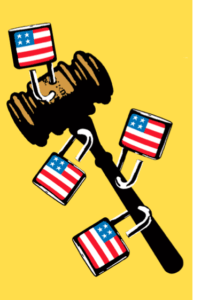 Judge’s & Prosecutor’s Jurisdiction– SCOTUS RULINGS on Judicial & Prosecutorial Conduct
Judge’s & Prosecutor’s Jurisdiction– SCOTUS RULINGS on Judicial & Prosecutorial Conduct
Family Treatment Court Best Practice Standards
Download Here this Recommended Citation
Please take time to learn new UPCOMING
The PROPOSED Parental Rights Amendment
to the US CONSTITUTION Click Here to visit their siteThe proposed Parental Rights Amendment will specifically add parental rights in the text of the U.S. Constitution, protecting these rights for both current and future generations.
The Parental Rights Amendment is currently in the U.S. Senate, and is being introduced in the U.S. House.


